
In a meeting this week, I came to the frightening realization everyone present was assuming something different. Yes, we were all there to finalize the door order. But the supplier, builder, designer, client and even myself had different ideas about how to specify the door’s swing or “handing”. I made a joke of it and chuckles rang out. But then we spent several minutes agreeing on the rules to avoid a bad order.
Handing is the traditional way a door’s swing is specified by suppliers. Swing is important, because it affects the placement of hardware and door bevel. But let’s face it, even architects and builders get confused. Translating floor plans into swing is difficult. The main problem? We all use different techniques to open the same door. Some of us place a shoulder against the door and grab with the same hand. Others, like me reach with the opposite hand.
So I’ve developed a simple method for determining handing that everyone (even the spatially challenged) can understand. Although this method is based on common practices, never assume a designer, builder or supplier understands swing this way, or at all. Even pros get it wrong. Sit down and talk. Doors are expensive. Changing door swing after fabrication is difficult. Be careful when viewing a catalog or shop drawings. Suppliers most usually provide drawings of the exterior view. It’s OK to ask which view is represented.
|
|
|
Exterior Doors
Stand on the inside (or imagine it so). Close the door. If the knob is on the right, it’s a right hand door. If the knob is on the left, it’s a left hand door. Exterior doors are that simple, well almost.
|
|
|
Most exterior doors swing inward. If your exterior door swings out, the above rules still apply. However, add the term “reverse bevel” to the door. In other words, if the knob is on the right, but the door swings out it’s a right hand reverse bevel door. Please keep in mind, some door suppliers call a right hand reverse bevel a left hand out swing, just to make life more complicated. Luckily the “reverse bevel” designation should call attention to the issue.
Interior Doors
Find the metaphorical inside of an interior door (when closed the hinges are visible). If the knob is on the left, it’s a left hand door. If the knob is on the right, yes it’s a right hand door. Reverse bevel doesn’t apply to interior doors.
|
|
|
Double Doors
Double French style doors work the same as single doors. But two doors adds confusion. Again, stand on the inside. One door panel is active and one is inactive. Imagine the active door by itself, which side of this door has the knob? Even though a right door panel is active, the knob is on the left so this door is left hand. Exterior out swing doors are “reverse bevel”.
|
|
|
Sliding Doors
Since sliding doors have knobs (or handles) on the outside instead of in the center like French doors. You must view these doors from the exterior. If the knob is on the left it’s a left hand door. If the knob is on the right it’s a right hand door. This applies even if both sides have fixed panels or two operable panels meet in the middle.
Pocket Doors
Pocket doors usually don’t have handing because they operate the same from both sides. Have you ever seen an exterior pocket door? However, locks must be installed on the correct side. Many locks for pocket doors are non handed or reversible.
Trivia
Most exterior doors swing inward. Outward swinging doors are possible, but many door makers void the warranty if their exterior door is installed to swing out. Especially for wood doors. Door makers worry their doors will be left open, get wet and warp.
Featured image is a watercolor based on a photograph by Juan Frito on Flickr Commons. All 3D drawings by Todd Remington.
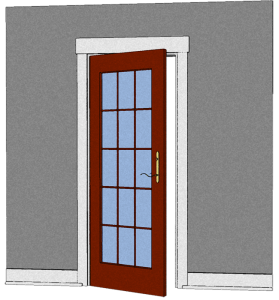
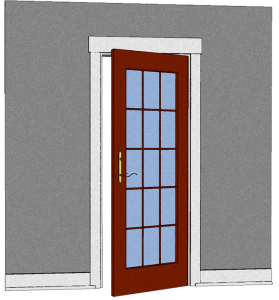
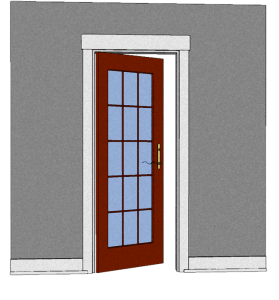
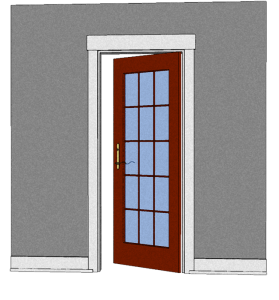
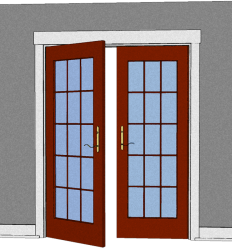
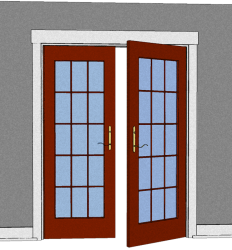
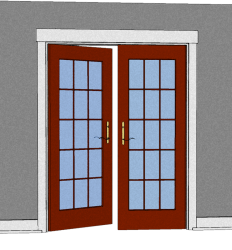
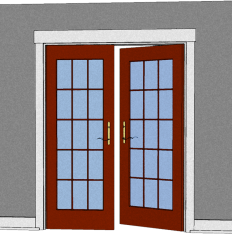
After trying to decipher several suppliers’ online catalogs for weeks, and after reading 6 or 7 “explanations” of door handing online today, I am about to explode with frustration. How is it that, after hundreds of years of door-building & installing, the industry cannot come to an agreement on this issue? I appreciate your efforts, and your article is well-written, but it won’t help until the industry adopts a clear & concise standard that makes sense to the average handyman. And I mean no disrespect, but I have one more question: how on earth do you think “reverse bevel” is less complicated/more clear than “outswing”?!